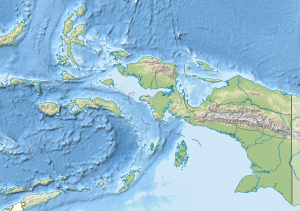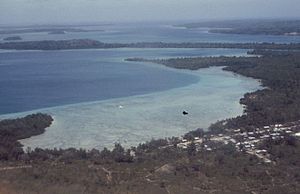Kei Dullah
| Kei Dullah | ||
|---|---|---|
| Map of the Kei Islands | ||
| Waters | Banda Lake , Seram Lake | |
| Archipelago | Kei Islands | |
| Geographical location | 5 ° 37 ′ S , 132 ° 46 ′ E | |
|
|
||
| main place | Tual | |
| Aerial photo of Tual (1980) | ||
Kei Dullah ( Kei Dulah ) is an island of the Kei Islands in the Moluccas Archipelago . On the west coast is Tual , the main town of the archipelago.
geography
Kei Dullah is the third largest of the Kei Islands and is located in the east of the archipelago between the larger Kei Kecil in the west and Kei Besar in the east, across the Nerong Strait .
Kei Dullah is administratively part of the autonomous city of Tual ( Kota Tual ), which also includes the smaller islands between Kei Kecil and Kei Dullah and northwest of Kei Dullah. Kei Dullah is divided into the two sub-districts ( Kecamatan ) Pulau Dullah Selatan ( South Tual ) and Pulau Dullah Utara ( North Tual ). Kota Tual is part of the Maluku Province and the administrative seat of the government district ( Kabupaten ) of Southeast Moluccas (Maluku Tenggara).
Unlike most of the other islands in the archipelago, Kei Dullah is flat and largely deforested.
Residents
The native population consists of Melanesians, who were joined by Malay ethnic groups and merged into one ethnic group, but remained separated into castes. There are also Javanese officials and soldiers in Tual. Land mostly belongs to the village community and arable land to the person who cultivates it. The residents of Kei Dullah traditionally speak the Austronesian language Kei ( Saumlaki, Veveu Evav ). The majority of the population is of Roman Catholic faith, and some are also Muslim. Tual is the center of the Muslims in the Kei Islands.
history
In 1888 the first Catholic mission of the archipelago was founded in Tual, which was relocated to the neighboring Langgur on Kei Kecil in 1890 .
In January 1999 there were clashes between Christians and Muslims on Ambon, which resulted in over 5,000 deaths and 500,000 refugees. The interreligious conflict also spread to other islands in the Central Moluccas, such as Seram, Buru , Tanimbar and also the Kei Islands, where it was not expected due to the harmonious coexistence of religions. On March 29, however, a 16-year-old boy wrote abusive comments on the walls of a mosque in Tual. The boy later claimed he was responding to anti-Jesus graffiti. Muslim protesters called for the perpetrator to be investigated and punished, but because he was under 17, the police let him go after a warning. The following night, barricades were erected and youth gangs attacked each other in Tual and Faan (a Christian suburb on Kei Kecil, south of Langgur) with machetes, spears, bows and arrows, bamboo cannons and Molotov cocktails. The Muslims with white headbands, the Christians with red. On the second day, the unrest spread to Kei Besar. The unrest did not end until June. A total of 200 people were lost to the Kei Islands, 30,000 people (a quarter of the total population of the Kei Islands) were displaced and 4,000 buildings were destroyed. Malaria and other diseases claimed more victims in the refugee camps.
economy
Tual is the main port of the Kei Islands, the airport is in the neighboring town of Langgur.
Individual evidence
- ↑ Map of the Maluku Province
- ↑ Penduduk Indonesia menurut desa 2010 ( Memento from March 27, 2014 in the Internet Archive ) (Indonesian; PDF; 6.0 MB), accessed on January 26, 2013
- ^ East Indonesia.info: Kei Islands
- ↑ a b c Encyclopedia Britannica
- ↑ a b c Musibah: Entitlements, Violence and Reinventing Tradition in the Kei Islands, Southeast Maluku, Paper submitted for the International Association for the Study of Common Property 9th Biennial Conference, Victoria Falls, Zimbabwe
- ^ Language map of the Moluccas and West Papua
- ↑ a b Ethnologue: Kei
- ^ East Indonesia.info: Tual & Langgur: The Twin Capitals of Kei




